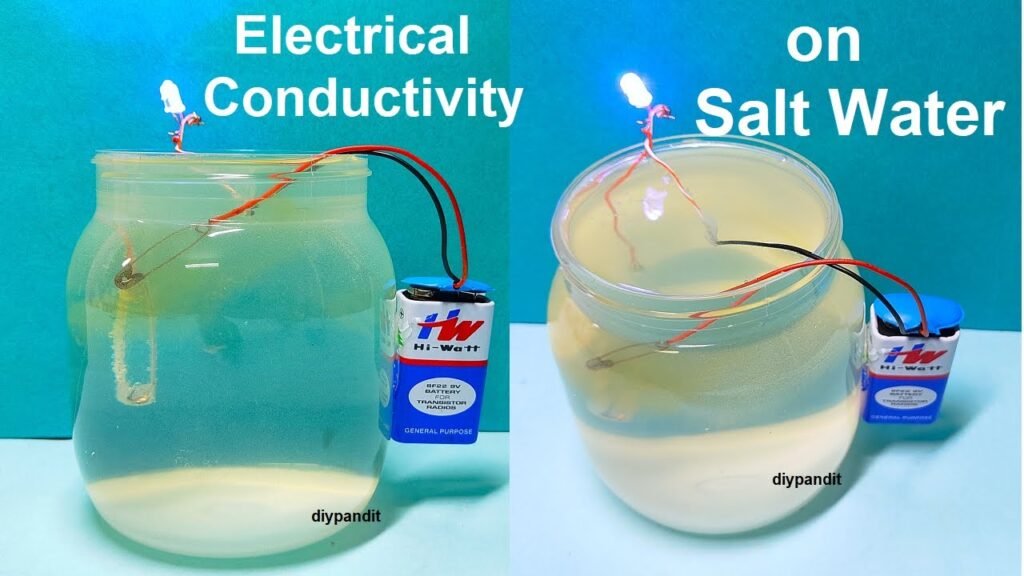Electrical conductivity in water refers to its ability to conduct an electric current. The presence of dissolved ions, such as salts, minerals, and other charged particles, allows water to conduct electricity.
When salt is added to water, it increases the concentration of ions, leading to higher electrical conductivity.
Here’s how electrical conductivity in water with added salt works:
Creating an electrical conductivity experiment using saltwater, safety pins, a wire, a 9V battery, a plastic bottle, and an LED light is a hands-on way to understand how conductive solutions can complete an electrical circuit and power a light source.

Here’s how you can set up the experiment:
Materials You’ll Need:
- Plastic bottle (empty and clean)
- Salt
- Safety pins (metal)
- Insulated wire with alligator clips (or stripped ends)
- 9V battery
- Water (for making saltwater solution)
- LED light
- Small container or cup
- Craft knife or scissors (for safety pin modifications)
- Safety goggles (recommended for eye protection)
Steps to Conduct the Experiment:
- Prepare the Safety Pins:
- Use a craft knife or scissors to carefully remove the plastic or protective coating from the tips of the safety pins, exposing the metal.
- Make Saltwater Solution:
- Mix salt and water in the small container to create a saltwater solution. Stir until the salt is fully dissolved.
- The saltwater will contain ions that can conduct electricity.
- Attach Wires to the Battery:
- Attach one end of the wire to the positive terminal of the 9V battery and the other end to the negative terminal.
- Prepare the Safety Pin Electrodes:
- Insert the exposed ends of the safety pins into the plastic bottle’s cap, creating two electrode points. These points will be submerged in the saltwater solution.
- Assemble the Setup:
- Fill the plastic bottle with the saltwater solution, leaving enough space at the top to close the cap with the safety pin electrodes.
- Connect Electrodes and LED Light:
- Close the cap with the safety pin electrodes submerged in the saltwater solution.
- Attach the alligator clips from the wire to the safety pin electrodes, completing the circuit.
- Connect the leads of the LED light to the wire ends. LEDs are directional, so make sure you connect the longer lead (anode) to the positive wire.
- Observe Conductivity and LED Glow:
- When the circuit is complete, the LED light should start to glow.
- The conductivity of the saltwater solution allows the electricity to flow and power the LED.
This experiment vividly demonstrates how a conductive solution like saltwater can complete an electrical circuit and power a light source. It’s an engaging way to explore electrical conductivity using simple components and observe the practical application of conductivity in powering devices.
electrical conductivity in water along with added salt questions asked in science exhibition with answers
Question 1: How does adding salt to water affect its electrical conductivity?
Answer: Adding salt to water increases its electrical conductivity because salt dissociates into ions (sodium and chloride ions) that can carry electric charge. The higher concentration of ions in the water allows electric current to flow more easily.
Question 2: How can we measure the electrical conductivity of water?
Answer: The electrical conductivity of water can be measured using a conductivity meter or probe. These devices apply a small voltage across the water and measure the resulting electric current. The higher the current, the higher the conductivity.
Question 3: Why is saltwater a better conductor of electricity than freshwater?
Answer: Saltwater contains a higher concentration of ions due to the dissociation of salt. These ions are charged particles that can move, allowing electric current to flow more easily. Freshwater has fewer ions, resulting in lower conductivity.
Question 4: Is there a limit to how much salt can be dissolved in water to increase its conductivity?
Answer: Yes, there is a saturation point beyond which no more salt can dissolve in the water. Beyond this point, adding more salt won’t further increase conductivity.
Question 5: Does the type of salt used affect the conductivity of water?
Answer: Different salts have different ion compositions. Some salts may dissociate into more ions than others, affecting the overall conductivity of the water when they’re dissolved in it.

